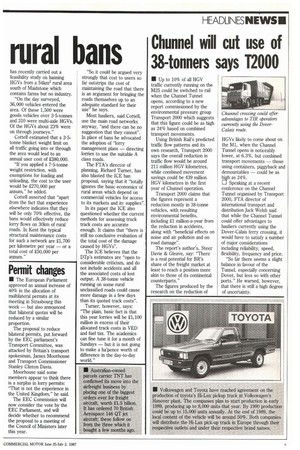Kent rebels at rural bans
Page 6

Page 7

If you've noticed an error in this article please click here to report it so we can fix it.
• A call by the Institution of Civil Engineers to ban all heavy goods vehicles from rural unclassified roads has been attacked as "totally impractical" by the Freight Transport Association, and even criticised by one of its own members, Kent County Surveyor Mike Cottell, for being too costly to industry.
In a background paper prepared for its conference The State of Roads and Bridges, held last week in London, the ICE claims that "there is little doubt that rural unclassified roads are unfit for heavy lorries, and there is absolutely no prospect that sufficient funds could be made available to strengthen them, something has to be done.
"The logical conclusion," according to ICE, "is to ban vehicles which cause the damage." The Institution says "for most purposes, lighter vehicles could cater for the required deliveries and collections", although it concedes that they would be "more costly to operate".
Even so, it maintains that "such extra costs, would be far less than the cost of repair or closure if those roads are not protected".
Where the use of heavy goods vehicles cannot be avoided, the ICE says that "a special licence could be issued at a cost which would cover the inevitable road damage". Kent County Surveyor Mike Cottell, however, has dismissed the idea as too costly. In his own paper at the conference, he explained that while "bans can be effective in urban areas, directing lorries on to more suitable roads where diversion distances are comparatively short, they are less effective in rural areas".
According to Cottell, Kent has recently carried out a feasibility study on banning HGVs from a 54km2 rural area south of Maidstone which contains farms but no industry.
"On the day surveyed, 36,000 vehicles entered the area. Of these 1,500 were goods vehicles over 3.5-tonnes and 310 were multi-axle HGVs. Of the HGVs about 23% were on through journeys."
Cottell estimated that a 35tonne blanket weight limit on all traffic going into or through the area would lead to an annual user cost of 2380,000.
"If you applied a 7.5-tonne weight restriction, with exemptions for loading and unloading, the cost to the user would be 2270,000 per annum," he added.
Cottell asserted that "apart from the fact that experience elsewhere indicates that they will be only 70% effective, the bans would effectively reduce lorry flows on 301cm of rural roads. In Kent the typical structural maintenance costs for such a network are 21,700 per kilometre per year — or a total cost of 250,000 per annum." "So it could be argued very strongly that cost to users so far outstrips the cost of maintaining the road that there is an argument for bringing the roads themselves up to an adequate standard for their use" he says.
Most hauliers, said Cottell, use the main road networks anyway, "and there can be no suggestion that they cannot". In place of bans he advocated the adoption of "lorry management plans — directing lorries to use the suitable A class roads.
The FTA's director of planning, Richard Turner, has also blasted the ICE ban proposal, saying that it "totally ignores the basic economics of rural areas which depend on commercial vehicles for access to its markets and its supplies".
In its paper the ICE also questioned whether the current methods for assessing truck track costs are accurate enough. It claims that "there is still no conclusive evaluation of the total cost of the damage caused by HGVs".
The ICE believes that the Dip's estimates are "open to considerable criticism, and do not include accidents and all the associated costs of lost output. A 38-tonne vehicle running on some rural unclassified roads could cause more damage in a few days than its quoted track costs".
Turner, however, says: "The plain, basic fact is that this year lorries will be 21,100 million in excess of their allocated track costs in VED and fuel tax. The academics can fine tune it for a month of Sundays — but it is not going to make a ha'pence worth of difference in the day-to-day world."




















































































































































